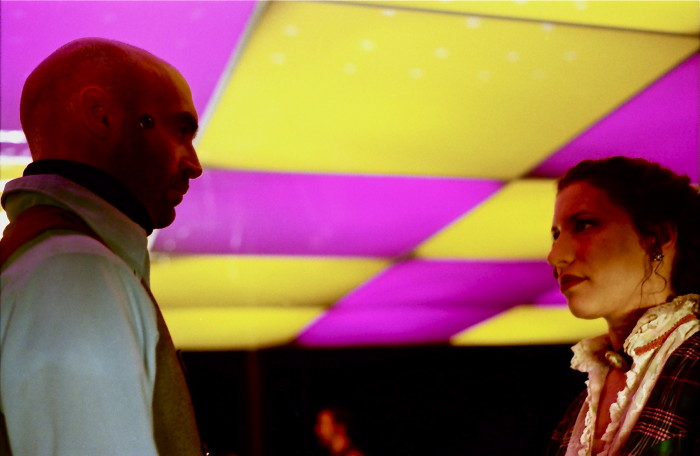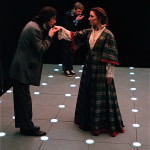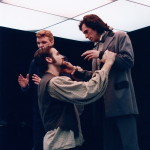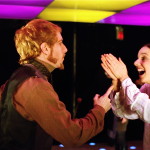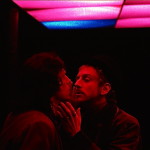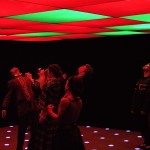Above, top to bottom: T. Ryder Smith and Jan-Peter Pedross; Thomas James Pasley and Kimberly Gambino; Jan-Peter, Connor Barrett, T. Ryder; James Ferguson and Erica Stuart; T. Ryder and James Ferguson; ensemble, with John Gould Rubin at left; Connor Barrett.
Excerpts from the reviews
“Kyle Chepulis’ magnificent lighting and cool set create the eerie virtual-reality game that is Blithedale, a 19th-century utopian society in which passion is punished and feminism is having trouble taking root. Matthew Pierce and Tim Schellenbaum have created music and sound design that guides the characters from future to past with chilling clarity . . . And the cast . . . is top-notch. . . I was intrigued and impressed, but . . . “ Matt Stewart, TimeOut NY
‘Blithedale’ invokes Brook Farm, the 19th-century transcendentalist utopian community . . . and sends it into cyberspace. With characters who now have virtual doubles, Hawthorne’s earthly mysticism undergoes a few electronic-age adaptations: the duos speak in unison as 19th-century and street-punk costumes mingle against the wails of phantasmagoric ambulance sirens . . . When the production is at it’s best Hawthorne drifts mind-blowingly in and out of a three-dimension internet. But . . . ” Martin Washburn, The Village Voice
“As one for whom the marvels of cyberspace remain something of a mystery . . . I felt through the opening scenes that I had wandered into a 1960’s Finnish-language Happening by mistake. But it gradually became clear that the characters on stage were only speaking cybertalk and that they were preparing to return to Hawthorne’s fictional Blithedale through some form of virtual reality . . . All of this is imaginative and clever in it’s way, but . . . “ Wilborn Hampton, The New York Times
Offstage
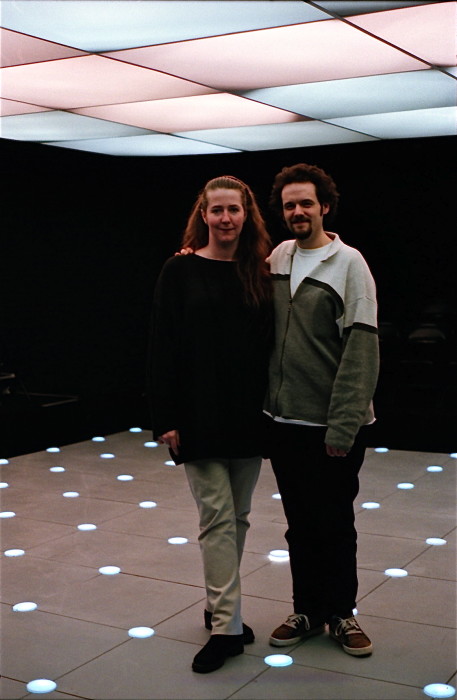
Full reviews
New York Times, Wilborn Hampton – Call It Transcendental Complication. In 1841, Nathaniel Hawthorne went to live at Brook Farm, a new commune in Massachusetts dedicated to creating a transcendental utopia. He left after several months, disillusioned with transcendentalism, but with enough material for a novel, ”The Blithedale Romance,” which he published a decade later. ”Blithedale: A Virtual Utopia,” which is being performed at Here in SoHo, is a theater piece that resembles nothing so much as a CD-ROM version of the novel. As one for whom the marvels of cyberspace remain something of a mystery (and who can still be daunted by Myst), I felt through the opening scenes that I had wandered into a 1960’s Finnish-language Happening by mistake. But it gradually became clear that the characters on stage were only speaking cybertalk and that they were preparing to return to Hawthorne’s fictional Blithedale through some form of virtual reality. The rest of the show is spent going back and forth between the present and the 19th century. Five contemporary characters, or role players, are matched by five ”sim” (for simulated) characters from Hawthorne’s novel. As they enact scenes from the book, the characters and their sims often speak in unison (or at least try to) and move about the stage, which resembles a boxing ring without ropes, in synchronization. Tim Maner, who is credited with having ”conceived” the show and is its director, has introduced some touches to lend verisimilitude to the concept of its being a virtual reality experience. The contemporaries put on dark glasses, sniff some sort of nasal spray and have wires connected to their heads. And each time a character enters or exits the stage, there is a whoosh sound and a voice-over announces the arrival or departure (”Zenobia is entering the area” or whatever). All of this is imaginative and clever in its way, but like many computer games it begins to get tedious once the novelty wears off. Playing at two-and-a-half hours, the cumulative effect is numbing. Without knowing the basic plot of Hawthorne’s novel, an audience can easily get confused. (A brief synopsis of ”The Blithedale Romance” in the program would not be amiss.) In the second act, things get even more complicated, with various characters ”entering” other characters, and the whole exercise turns into a sort of virtual reality Web surf. At one point, there seems to be a crash, or perhaps a memory overload. My inclination was to click on the ”help” icon. ”Blithedale: A Virtual Utopia” is the third of Hawthorne’s novels to be so adapted by Mr. Maner and there are passing references to ”A Scarlet Letter” and ”The House of Seven Gables” in this show. It is clearly a group effort. The other credits list Elizabeth Banks as writer and adapter, David Latham and Ruth Margraff as providing ”additional texts” and Tanya Elder as ”project cybrarian.” The cast of 11 is enthusiastic, even if the performances often seem like an acting-class improvisation. Matthew Pierce composed music for the show, and an extended song and 19th-century dance in the first act is entertaining. 4.17.98
[previous] [next]

